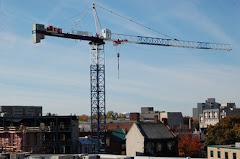 If you've rode on transit lately, you'll have witnessed a growing, but silent, sense of disgruntlement from the drivers. You might recognize these flyers, either taped up on bus shelters, left out in public areas or slipped to dedicated riders on the Q.T.
If you've rode on transit lately, you'll have witnessed a growing, but silent, sense of disgruntlement from the drivers. You might recognize these flyers, either taped up on bus shelters, left out in public areas or slipped to dedicated riders on the Q.T.In no uncertain terms these flyers say that the members of the transit union are fed up, and they're trying to rally support from loyal transit users to kick up a storm.
 Smart strategy considering that the city's bus lines are returning to 30 minute service all week long for three months starting in June, there's going to be no Sunday service at all in August, and from the U-pass to adult tickets, everybody's seen a fare increase in the last couple of months.
Smart strategy considering that the city's bus lines are returning to 30 minute service all week long for three months starting in June, there's going to be no Sunday service at all in August, and from the U-pass to adult tickets, everybody's seen a fare increase in the last couple of months.Transit workers have got their own reasons to be ticked too. About 31 transit employees will be laid off between June and August, or otherwise have their hours severely cut back. This while the City talks about the priority of transit and all its future plans, which kind of comes off looking like a lot of double speak. In the meantime, the drivers, the front line workers, probably are taking the brunt of the abuse for all of transit's recent shortfalls.
Below is a scan of the one side of the flyer. The opposite side had all the contact info for Mayor and council:
 On a second note, I came across this the other night while riding the bus home:
On a second note, I came across this the other night while riding the bus home: What? You ask. Sure it's a little in advanced... But actually, this is from October 2005. How do I know? Because I remember this event being advertised when I was working my first ever journalism job as Arts & Culture Editor of the University of Guelph Ontarion.
What? You ask. Sure it's a little in advanced... But actually, this is from October 2005. How do I know? Because I remember this event being advertised when I was working my first ever journalism job as Arts & Culture Editor of the University of Guelph Ontarion.But this leads to a question I've had about transit for awhile. We have all this ad space on city buses and the only ones who seem to use it anymore are various levels of government and the Central Student Association. Furthermore, many of the ads you do see are horribly outdated. Isn't this another revenue stream that can be accessed, thus making sure that the city doesn't have to resort to amended service hours to make up extra cash in the budget?
I'm interested in knowing why this [ample] space continues to go unused. Is it a time issue? No one has time to chase down potential advertisers? Or is this a class thing? Only people of limited means can ride the bus, people that don't have a lot of disposable income lying around. Ergo, they're not worth the time and money to advertise to. Ergo, no one will advertise on the city buses.
I hope this is not the case, because it just perpetuates a negative and wholly nonfactual point of view that public transit is for poor people only. Still, I would love to know where all the advertising went on our city buses.


















1 comment:
Its a good thing people are raising social awareness about these issues by detailing the facts. But these type of cutbacks aren't just limited to Guelph, but have been happening systematically in all municipalities across our country for the past 15 years or so, full steam. Higher taxes and declining services beg the question alluded to in the flyer, "where does all the money go?"
Its sad thought that many people get caught up in the angry right-wing populist propaganda and blame the public sector and its employees for cutbacks, always intimating that it is somehow their performance, attitudes or abilities which are to blame for this whole mess. But when one stops to think about the role of government vs business, government was never designed to operate as a business; its intent was never the single-minded zeal of "making profit for its shareholders".
The causes of the systematic dismantling of public assets seen in our crumbling infrastructure, healthcare service underfunding, declining wages, public transit cuts, etc, are driven by the burgeoning corporate state in collusion with the neoliberal agenda which has been adopted by both "mainstream" political parties.
Post a Comment